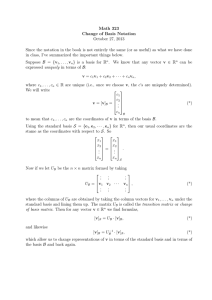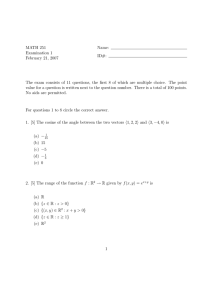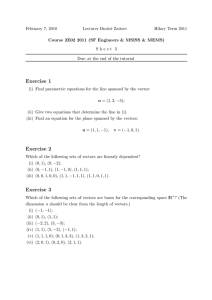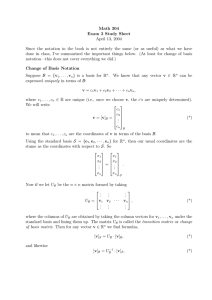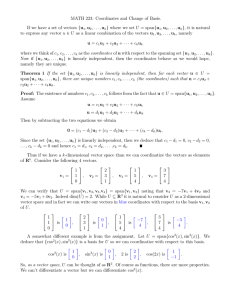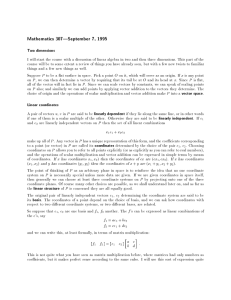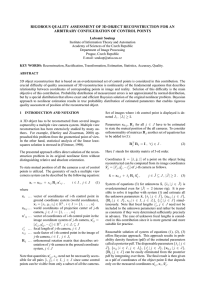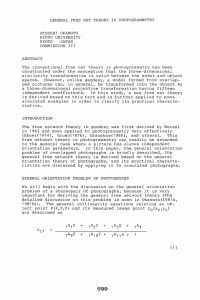Math 304 Exam 2 Sample Problems Final Version March 28, 2004
advertisement
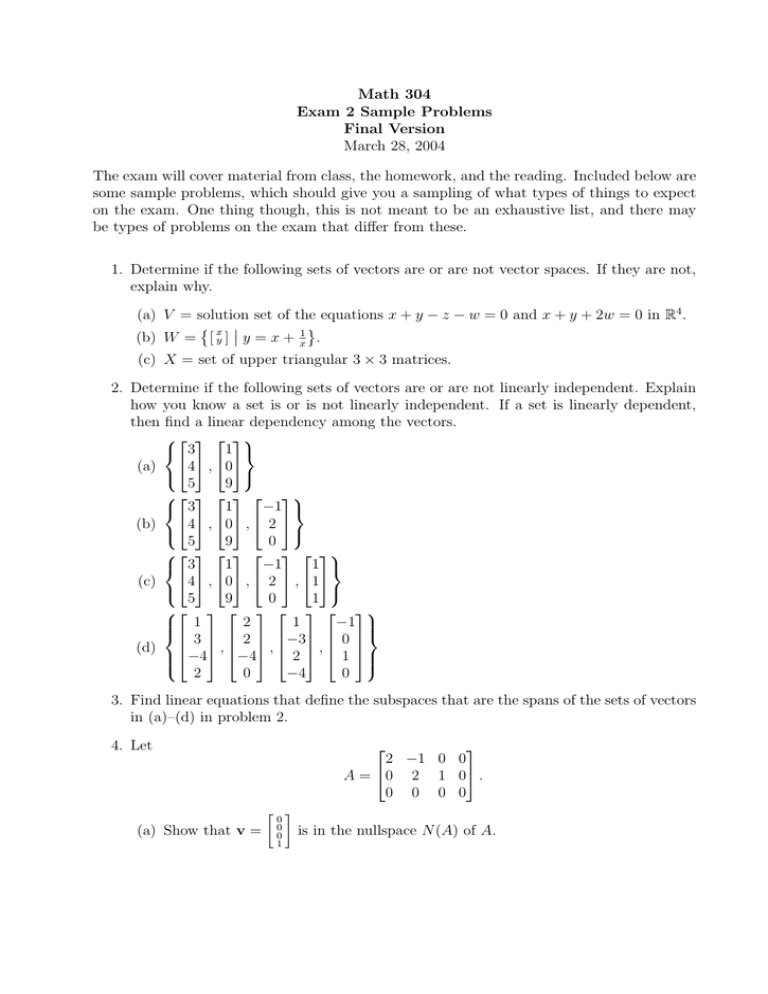
Math 304
Exam 2 Sample Problems
Final Version
March 28, 2004
The exam will cover material from class, the homework, and the reading. Included below are
some sample problems, which should give you a sampling of what types of things to expect
on the exam. One thing though, this is not meant to be an exhaustive list, and there may
be types of problems on the exam that differ from these.
1. Determine if the following sets of vectors are or are not vector spaces. If they are not,
explain why.
(a) V = solution set of the equations x + y − z − w = 0 and x + y + 2w = 0 in R4 .
(b) W = [ xy ] y = x + 1 .
x
(c) X = set of upper triangular 3 × 3 matrices.
2. Determine if the following sets of vectors are or are not linearly independent. Explain
how you know a set is or is not linearly independent. If a set is linearly dependent,
then find a linear dependency among the vectors.
1
3
(a) 4 , 0
5
9
1
−1
3
(b) 4 , 0 , 2
5
9
0
1
−1
1
3
4 , 0 , 2 , 1
(c)
5
9
0
1
1
2
1
−1
3 2 −3 0
(d) , , ,
−4
−4
2
1
2
0
−4
0
3. Find linear equations that define the subspaces that are the spans of the sets of vectors
in (a)–(d) in problem 2.
4. Let
2 −1 0 0
A = 0 2 1 0 .
0 0 0 0
(a) Show that v =
0
0
0
1
is in the nullspace N (A) of A.
(b) Find linear equations that define N (A) as a subset of R4 .
(c) Find a basis of N (A) that contains v.
(d) What is the dimension of N (A)?
nh i h i h io
nh i h i h io
0
0
1
1
0
1
0 , 1 , 0
1 , 0 , 1
5. Let S =
be the standard basis of R3 . Let A =
and
1
0
1
1
nh i h0 i h0 0 io
1
1
1
1 , 0 ,
B=
.
−1
0
1
(a) Show that A is a basis for R3 . Show that B is not a basis for R3 .
(b) Find a linear equation (or equations) whose set of solutions is Span(B).
h i
3
(c) Find the coordinates of 4 with respect to the basis A. (You may want to do
5
the next part first.)
(d) Find the change of basis matrix which converts coordinates in the S-basis into
coordinates in terms of the A-basis.
Additional Problems from Leon:
• 2.2: 8, 9, 10
• 3.1: 3, 4, 10
• 3.2: 3, 4, 9
• 3.3: 1, 2, 16
• 3.4: 1, 2, 6, 7
• 3.5: Problems in HW
Change of Basis Notation
Suppose B = {v1 , . . . , vn } is a basis for Rn . We know that any vector v ∈ Rn can be
expressed uniquely in terms of B:
v = c1 v1 + c2 v2 + · · · + cn vn ,
where c1 , . . . , cn ∈ R are unique (i.e., once we choose v, the c’s are uniquely determined).
We will write
c1
c2
v = [v]B = ..
.
cn B
to mean that c1 , . . . , cn are the coordinates of v in terms of the basis B.
Using the standard basis S = {e1 , e2 , · · · , en } for Rn , then our usual coordinates are the
stame as the coordinates with respect to S. So
x1
x1
x2 x2
.. = .. .
. .
xn
xn S
Now if we let UB be the n × n matrix formed by taking
.
..
..
..
.
.
UB = v1 v2 · · · vn ,
..
..
..
.
.
.
where the columns of UB are obtained by taking the column vectors for v1 , . . . , vn under the
standard basis and lining them up. The matrix UB is called the transition matrix or change
of basis matrix. Then for any vector v ∈ Rn we find formulas,
[v]S = UB · [v]B ,
and likewise
[v]B = UB−1 · [v]S ,
which allow us to change representations of v in terms of the standard basis and in terms of
the basis B and back again.
If A = {u1 , u2 , . . . , un } is another basis for Rn , then we can interchange between B-basis
representations and A-representations: for any v ∈ Rn ,
[v]A = UA−1 UB · [v]B
and likewise
[v]B = UB−1 UA · [v]B .

![MA1S11 (Timoney) Tutorial/Exercise sheet 1 [due Monday October 1, 2012] 1. 5](http://s2.studylib.net/store/data/010731543_1-3a439a738207ec78ae87153ce5a02deb-300x300.png)
